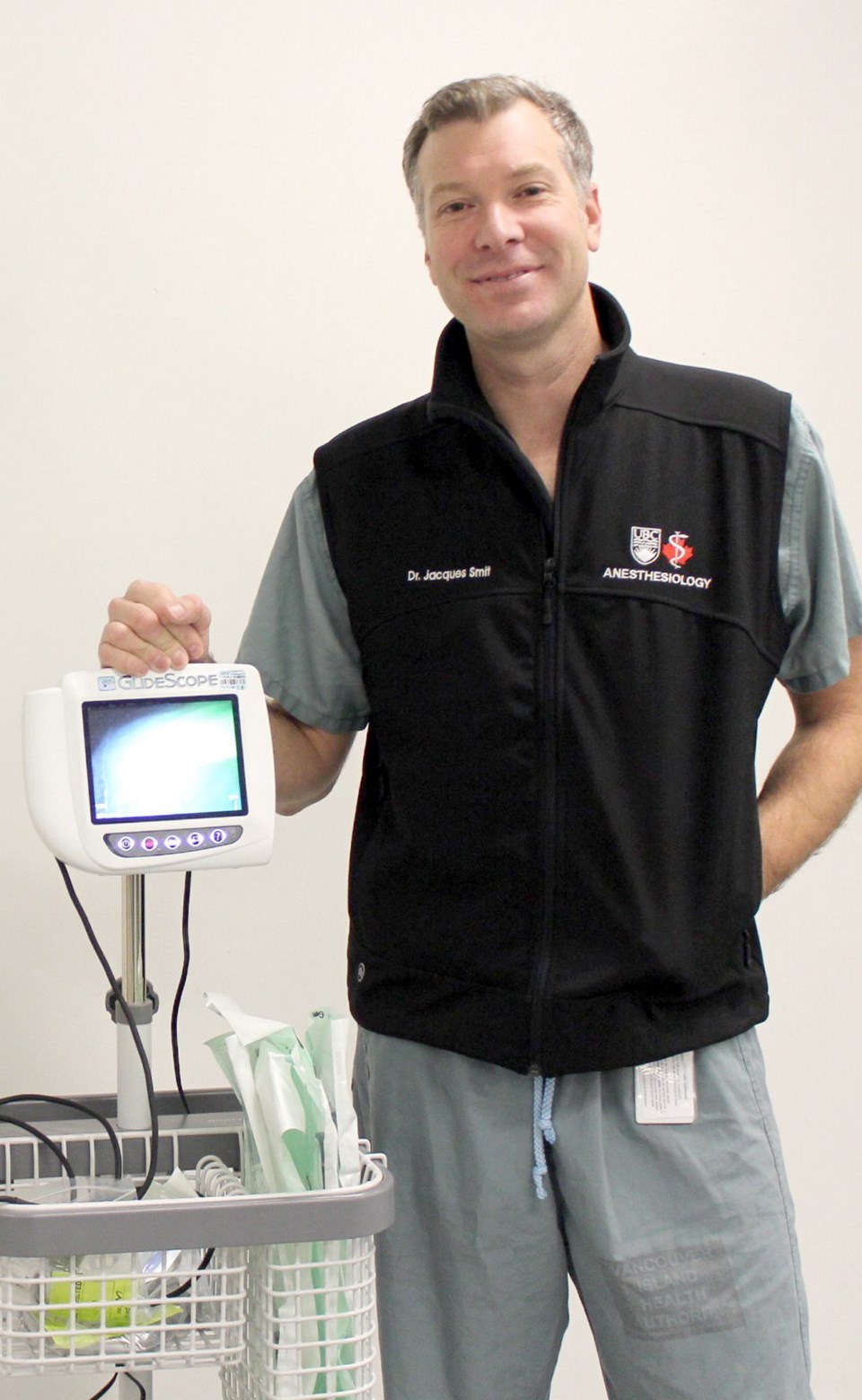Anesthetists at Victoria’s two main hospitals are relying on new equipment to help them insert breathing tubes into patients with complicated airways after a shortage of the devices proved unbearable.
Difficult-intubation scopes are vital in helping doctors see where they are placing breathing tubes.
On any given day they are used 10 to 15 times between Victoria General and Royal Jubilee hospitals, said anesthesiologist Dr. Jacques Smit.
Not only are the new scopes in high demand, but they are constantly in circulation being sent off to be cleaned and sterilized.
The candy-cane or hook-shaped battery-operated scope has a handle on one end and a light and a camera on the other tip. The scope is inserted in a patient’s mouth, around the tongue and toward the vocal cords.
Once there, the image of the vocal cords is projected on the machine’s screen and allows doctors to see towards the trachea. The separate breathing tube can then be inserted and follow the same path as the scope, which can be retracted once the breathing tube is in place.
Despite their high use, the two hospitals owned only three decade-old scopes — one at Victoria General and two at Royal Jubilee — leaving the hospitals “in a tight spot.”
Smit is at Victoria General Hospital. “[The scope is] obsolete, it’s broken and, basically, we [were] pretty vulnerable and running on a bit of an edge here,” Smit said.
Patient safety was not compromised because this summer and early fall both hospitals each acquired five new “loaner” scopes. The Victoria Hospitals Foundation is in the process of purchasing them.
The foundation hopes funding will come from its fall campaign to raise $1.8 million for Victoria’s two biggest hospitals. Money from the fundraiser will help with the purchase of 12 digital difficult-intubation scopes at $22,715 each. The hospitals also need one $22,000 transcutaneous carbon dioxide monitor which measures blood gases.
The fundraising goal was helped along by the foundation’s Visions gala last week at the Empress Hotel, which raised a record $619,000.
Born and raised in South Africa, Smit, 42, cites an article in the medical journal The Lancet that says mortality associated with anesthesia between 1990 and 2000 was 34 per million anesthetics (25 per million for the same period in Canada).
Prior to 1970s, the mortality rate with anesthesia in developed countries, was 360 deaths per million.
“A lot of the mortality 20 or 30 years ago was related to not being able to get that breathing tube in the right place simply because they couldn’t see where they needed to go,” said Smit. A breathing tube is used in about 50 per cent of surgeries requiring anesthesia.
For “a few select patients” — because of their unique physiology such as a small mouth or jaw — inserting an intubation tube can be difficult. A scope is required to help doctors safely direct the tube at tight spots through the throat.
“If you have the patient asleep, and go to put the breathing tube in and can’t, it’s a dangerous situation,” said Smit. “When you can’t see what you’re doing, there is a bigger risk of trauma, or it could go in the wrong place, which is the biggest contributor to mortality in anesthesiology.”
Most of the improvements today, compared to half a century ago, are due to safer ways of protecting the airway and lungs, as well as better transfusion practices and availability of equipment and education, said Smit.
Risk factors include being very young (an infant) or very old, overall health, previous surgeries, and frailty in combination with the type of surgery.
Smit wound his way here via England, Prince Rupert and Vancouver.
He married a Canadian and settled in Victoria about five years ago, not only for the life balance it offers but because the hospitals here allow anesthetists to practise in all areas — cardiac, vascular and thoracic surgery at Royal Jubilee, and obstetrics, pediatrics, trauma and neurosurgery at Victoria General.
Before surgery, anesthetists meet with patients to hear their concerns and understand their medical conditions, physiology and psychology.
About 80 per cent of patients “are very anxious about the anesthetic,” said Smit. The fears are highly personal and age dependent. An example of the questions Smit hears: Will I wake up during surgery or wake up at all? Will I wake up to pain? What happens when I lose control and fall unconscious?
“It’s this time warp where no one really knows what happens,” said Smit. “It’s hard to let go and give up control.”
Smit tries to reassure patients that going under with an anesthetic is generally speaking safer than driving home from the hospital.



